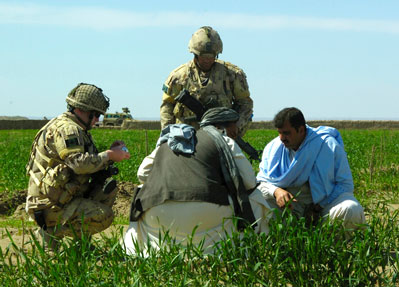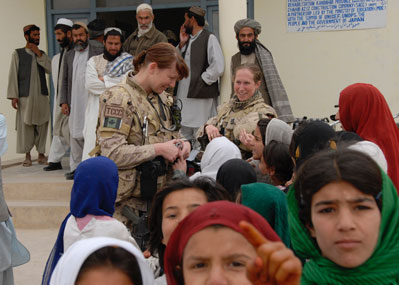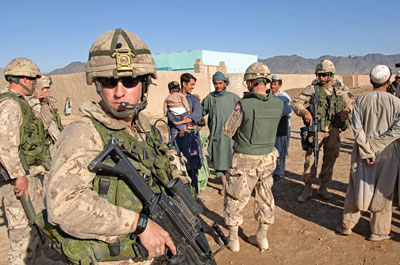 This information has been archived for reference or research purposes.
This information has been archived for reference or research purposes.
Archived Content
Information identified as archived on the Web is for reference, research or recordkeeping purposes. It has not been altered or updated after the date of archiving. Web pages that are archived on the Web are not subject to the Government of Canada Web Standards. As per the Communications Policy of the Government of Canada, you can request alternate formats on the "Contact Us" page.
Views and Opinions

DND Photo AR2007-A035-044 by Sergeant Craig Fiander
Captain Richard Nolan (left), and Captain Clayton Ereaut, both Reservists from Newfoundland, at a pomegranate tree nursery project in Kandahar Province, where they were members of the Kandahar Provincial Reconstruction Team, 1 April 2007.
Re-evaluating the Role of Reserve Officers in the CF
by Daniel A. Doran
For more information on accessing this file, please visit our help page.
Introduction
Over the past several years, the Canadian Forces (CF) has made several attempts to reorganize the reserves in a manner to make them more relevant to the organization at large. These attempts have included concepts such as the Territorial Defence Brigades (TDBG), and the ‘de-streaming’ of training between the two components of the army. Approaches such as these have resulted in varying degrees of failure. These failures are attributable to the regular army’s lack of knowledge of reserve culture, in addition to attempts to template and shift reserve culture to one more akin to the regular forces. In the case of the TDBG, the CF failed to properly appreciate the reserve army attachment to the traditional regimental system. With respect to de-streaming training, the CF failed to take into account the limited training windows available to reserve personnel. The challenges faced by the Canadian Army Reserves in the 21st Century are broad and complex, and this short article will in no way attempt to address all of them. However, it will attempt to provide an examination of the role of the army reserve officer corps within the context of the Canadian Forces. Further, it will identify some of the more urgent challenges faced by this cross-section of CF personnel and how those challenges can be addressed in order to assure CF reserve officer relevance within the current paradigm of operations.
The Reserve Officer Corps
This corps is organized administratively in a similar manner to their non-commissioned counterparts: i.e., Class A, Class B, and Class C personnel. In simplified terms, Class A reservists consist of those employed on a purely part-time basis; i.e. parading at their respective armouries one evening a week and one weekend a month. Class B reservists are those that work full-time under contracts of various lengths. These contracts may take the form of summer employment of candidates or staff as well, and also through filling long-term positions within the CF structure. Lastly, Class C reservists represent those deployed on operations – for instance, reservists supplementing battle groups deployed to specific theatres such as Afghanistan.
Since the events of 9/11, the reserve forces have played an increasingly important role within the CF – supplementing regular force elements on operations in Afghanistan, as well as supporting training and staffing at various schools and headquarters, due to the absence of sufficient regular force personnel as a result of high deployment tempos. These realities have been of a great benefit to the NCM cadre of the reserves, providing Class C soldiers invaluable experience in current operations, as well as making available tremendous potential for ‘cross-pollination’ and mentoring by the regular army. As a result, these dedicated soldiers have improved the capacities of the armouries through the sharing of experiences and training with their Class A counterparts.
Problems, Problems…
This experience, however, has not been reflected in the same manner with the reserve officer corps. This is due, in large part, to how the regular forces have chosen to segregate reserve officer operational opportunities. Reserve officers have been streamed away from the battle groups, with the more junior members being placed in specialized units, such as Civilian Military Co-operation (CIMIC), Human Intelligence (HUMINT), and Psychological Operations (PSYOPS). Senior officers have been almost universally relegated to obscure staff positions within deployed higher headquarters. While this has created a ‘niche’ for reservists within the counter-insurgency (COIN) context, it has nonetheless segregated reserve officers from attaining the mainstream experience; training and mentoring that can only be gained through conventional employment in a deployed battle group.
A second factor negatively affecting the enhancement of professional development for reserve officers is the ‘stove-piped’ manner by which they are trained. Most notably, this applies to those who choose to be employed on a full-time (Class B) basis. This means that many reserve officers are sequestered within their reserve brigade structure for years on end with little exposure ‘beyond their cubicle,’ which, in the administrative fields, has led to boredom in the workplace.1 This, in turn, can lead to all the problems endemic to prolonged employment within a static work environment, including, but not restricted to, low morale, and “… an overall weak concern about growth and development on the job.”2 While these scenarios are not ubiquitous, they nonetheless represent a significant cross-section of reserve officers at risk, or those who are actually victims of a syndrome that leaves them uncompelled to seek experiences outside their immediate zone of comfort.

DND Photo IS2007-1032 by Sergeant Roxanne Clowe
Captain Rhonda Matthews, a Reservist with the Princess Louise Fusiliers, and Warrant Officer Lori Coady, a Reservist with 36 Service Battalion, play with children at the Said Abad School in Kandahar City, Afghanistan, 3 April 2007.
Lastly, and perhaps one of the most important elements that act as a detriment to the army reserve officer corps, is the growing apathy of the regular forces toward providing reserve organizations with meaningful support. This is embodied in the shrinking number of regular force members posted to regular support staff positions and reserve brigade headquarters staffs. It has led to a lack of adequate mentorship for young Class A officers at the unit level, and has resulted in critical personnel and experience gaps among full-time staffs at the headquarters level. As a result, these position gaps must be filled by reserve personnel who do not necessarily meet all the ideal criteria for a given position, due to manpower shortages increasingly prevalent in the reserves. These young reserve officers are left with limited guidance, and they are over-employed, and, as such, risk “qualitative overload.” This is a product of being given work of a nature and complexity beyond the reasonable capacity of an employee.3 Prolonged exposure to this type of work environment can create disgruntled and frustrated personnel, leading to them choosing careers other than the army, thus causing further shortages to an already-challenged structure.
These problems have been exacerbated by policies drafted by the CF leadership to allow reserve personnel with operational experience easy transfer to the regular forces.4 This equates to ‘robbing Peter to pay Paul.’ By pilfering reserve units of their most experienced personnel, the regular army negatively affects the capacity of the reserves to generate, train, and mentor younger reservists who might later be compelled to deploy with the regular army. While statements such as these will be argued as non-quantifiable, it could be argued that the stagnating growth of the reserves lends this hypothesis credibility.5
Possible Solutions
Solutions to these challenges are not as complex as some are led to believe. They involve (1) the re-investment of human resources on the part of the regular army, in addition to (2) providing reserve officers with a seat at the regular army table.
The first recommendation could be achieved by simply returning to the old structure of regular army support to the reserves though the attachment of regular army officers to reserve armouries in order to foster mentorship for junior leaders. Additionally, this would require a return and growth of regular army support to reserve brigade headquarters, filling more positions within the G-staff to afford reserve structures the support and mentorship they are rightfully entitled to as full-time employees of the CF.
The second recommendation could be addressed by opening up more important positions within the regular army regimental and brigade structures for reservists. This could include employing reservists as assistant operations officers, assistant adjutants, and company 2 I/Cs, as well as battalion deputy commanders and service in various G-staff appointments. Allowing reserve officers the opportunity to gain the experience and mentorship available within regular force brigades would no doubt assist in re-invigorating reserve leadership and staffing capacities when they return to their respective reserve brigades and assist in providing a more consistent standard throughout reserve and regular army components of a land force region. Lastly, this initiative would allow full-time reservists a semblance of the variety in employment available to regular force personnel, alleviating the risk of chronic boredom within the reserve structure.
Conclusion
The most important factor to draw out of what has been discussed herein is the necessity to give reserve officers greater exposure to the workings of their profession through offering them employment in a greater variety of environments. This is the philosophy embraced by the regular army by virtue of its posting of personnel to different positions every three to four years. This philosophy is intended to continually develop not solely depth, but the breadth of knowledge within the officer cadre of the CF. The wider the experience base of officers, the more apt they are to address and solve challenges in a sound and timely manner. These are professional development opportunities that should be afforded to all elements of the officer corps, and not solely the property of those who choose to serve in the regular army. The initiatives outlined here might also provide a means of greater professional exposure to those who prefer to serve part-time or in a specific geographical location by bringing the aforementioned opportunities to them. Applying both these recommendations would serve to accommodate permutations of the reserve officer corps, and would permit more rapid and effective development within the CF, which would, in turn, better equip members to contribute to the overall goals of their specific organizations, as well as to the CF at large.

DND Photo IS2005-0448 by Master Corporal Robert Bottrill
Corporal Eugene Ivens, a Reservist with the 48th Highlanders from Toronto, conducts perimeter security while Canadian Forces soldiers from the Provincial Reconstruction Team talk to Afghan locals in a Kandahar neighbourhood, 21 November 2005.
![]()
Captain Daniel A. Doran, a combat engineer, holds a Bachelor’s Degree in Civil Engineering from the Royal Military College of Canada, and a Master’s Degree in Human Security and Peace Building from Royal Roads University. He has served as Deputy Task Force Engineer in Afghanistan during ROTO 01 of Op Athena, and has recently deployed as a United Nations Military Observer to Sudan. He is currently 2 I/C of 24 Field Squadron at 2 Combat Engineer Regiment, CFB Petawawa.
Notes
- http://www.tda.gov.uk/about/mediarelations/2006/20060727.aspx?keywords=boredom
- Cynthia D. Fisher, “Boredom at Work: A Neglected Concept,” in Human Relations, Vol. 46, No. 3,, p. 405.
- Ibid, p. 397.
- http://www.admfincs.forces.gc.ca/cfa-oaf/index-eng.asp
- http://www.tbs-sct.gc.ca/dpr-rmr/2007-2008/inst/dnd/dnd01-eng.asp






